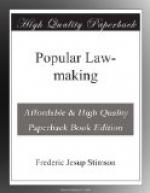In closing it may be wise to run over the actual labor laws passed in the States during the last twenty years, mentioning the more important lines of legislation so as to show the general tendency.
Beginning in 1890 we find most of the statutes concern the counterfeiting of union labels, arbitration laws, hours of labor in State employments, weekly payment laws, the preference of debts for labor in cases of insolvency, the prohibition of railroad relief funds, the hours of women and children in factories, seats for women in shops, the restriction of prison labor, dangerous machinery in factories, protection in mines, and the incorporation of trades-unions. Mechanics’ lien laws are passed in large quantities every year and are the subject of endless amendment. We will, therefore, leave this out for the rest of our discussion as after all affecting only the owners of real estate.
In 1891 we find more laws regulating or limiting the hours of labor of women and children, prohibiting it entirely in mines; several anti-truck laws; two laws against the screening of coal before the miner is paid, and in Massachusetts, laws against imposing fines for imperfect weaving and deducting the fine from the wages paid. Pennsylvania thinks it necessary to enact by statute that a strike is lawful when the wages are insufficient or it is contrary to union rules to work, which latter part is clearly unconstitutional. There is one statute against boycotting and three against blacklisting.
In 1892 there are more laws limiting the hours of labor of women and children to fifty-eight, or in New Jersey, fifty-five, hours a week; laws against weavers’ fines, and restricting the continuous hours of railway men. The sweat-shop acts first appear in this year, and the statutes forbidding the discharge of men for belonging to a union or making a condition of their employment that they do not belong to one.
In 1893 the laws establishing State bureaus of labor become numerous. Four more States adopt sweat-shop laws, and there is further regulation of child labor. Six States adopt statutes against blacklisting.




